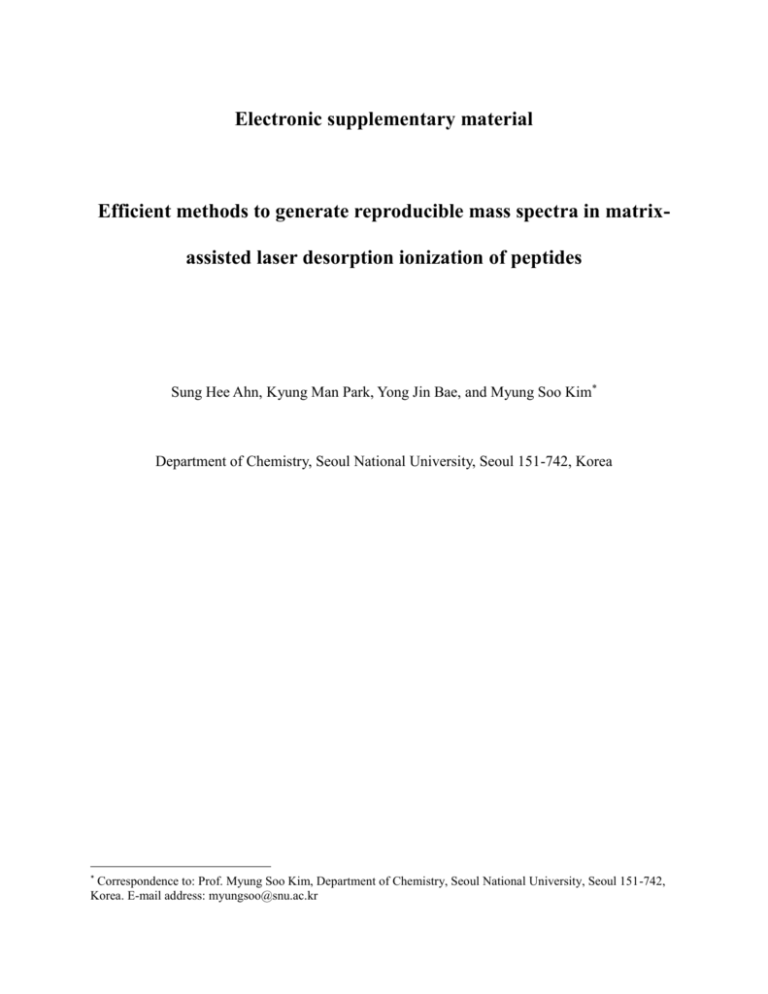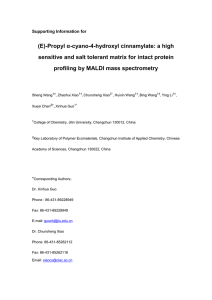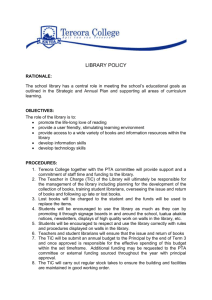2. Quantitative reproducibility of TIC
advertisement

Electronic supplementary material Efficient methods to generate reproducible mass spectra in matrixassisted laser desorption ionization of peptides Sung Hee Ahn, Kyung Man Park, Yong Jin Bae, and Myung Soo Kim* Department of Chemistry, Seoul National University, Seoul 151-742, Korea * Correspondence to: Prof. Myung Soo Kim, Department of Chemistry, Seoul National University, Seoul 151-742, Korea. E-mail address: myungsoo@snu.ac.kr 1. Termination of ion generation after repetitive irradiation of laser pulses with two times the threshold and its resumption when the pulse energy is raised Figure S-1. MALDI spectra of 10 pmol Y5K in 25 nmol of CHCA averaged over the shot number range of (a) 31-40 and (b) 291-300 with two times the threshold laser pulse energy. Ion generation virtually stopped at the shot number 300. (c) Ion generation resumed when the pulse energy was raised to three times the threshold. 2. Quantitative reproducibility of TIC-selected MALDI spectra obtained at different laser pulse energies Figure S-2. TIC-selected MALDI spectra for a vacuum-dried sample of 10 pmol angiotensin II in 25 nmol CHCA obtained with (a) two, (b) three, and (c) four times the threshold laser pulse energy. From a set of spectra obtained by repetitive irradiation of a spot, those with TIC of 900180 ions/pulse were selected and averaged. 3. Tearly vs. TIC data in CHCA-MALDI Figure S-3. Tearly vs. TIC data. A set of MALDI spectra was taken for 10 pmol Y5K in 25 nmol CHCA by repetitive laser irradiation. TIC in each spectrum was calculated by taking into account the detector gain vs. m/z. The survival probability of the peptide ion at the source exit was also calculated for each spectrum and was converted to Tearly through kinetic analysis [1, 2]. 4. Quantitative reproducibility of TIC-selected CHCA-MALDI spectra obtained for vacuum-dried samples 4-1) Reduction of spot-to-spot spectral variation by TIC selection Figure S-4. TIC-selected MALDI spectra taken from the spot number (a) 1, (b) 4, and (c) 9 on a sample with 10 pmol Y5K in 25 nmol CHCA. Spectra with TIC of 1100200 ions/pulse were selected and averaged. The locations of the spots are marked in the photograph. Ion signals represent the raw outputs of the detection system. 4-2) Reduction of spectral variation arising from sample thickness by TIC selection Figure S-5. Two vacuum-dried samples were prepared by loading (a) 1.0 and (b) 2.0 µL of a solution containing 10 pmol Y5K and 25 nmol CHCA per 1.0 µL. A set of MALDI spectra was obtained from each sample by repetitive laser irradiation. From each set, spectra with TIC of 1100200 ions/pulse were selected and averaged. Thicknesses of the samples in (a) and (b) were around 1.5 and 2.1 µm, respectively. 5. Quantitative reproducibility of TIC-controlled CHCA-MALDI spectra obtained for vacuum-dried samples 5-1) Reduction of spot-to-spot spectral variation Figure S-6. TIC-controlled MALDI spectra taken from the spot number (a) 1, (b) 4, and (c) 9 on a sample with 10 pmol Y5K in 25 nmol CHCA using the preset TIC of 900 ions/pulse. The locations of the spots are marked in the photograph. Ion signals represent the raw outputs of the detection system. Data acquisition was terminated when the pulse energy became three times the threshold. Average was taken for the spectra acquired from each spot. 5-2) Reduction of spectral variation arising from sample thickness by TIC control Figure S-7. Two vacuum-dried samples were prepared by loading (a) 1.0 and (b) 2.0 µL of a solution containing 10 pmol Y5K and 25 nmol CHCA per 1.0 µL. For each sample, TICcontrolled MALDI spectra were obtained using the preset TIC of 900 ions/pulse. Thicknesses of the samples in (a) and (b) were around 1.5 and 2.1 µm, respectively. 6. Calibration curve in TIC-controlled MALDI of vacuum-dried samples of angiotensin II in CHCA Figure S-8. Calibration curve for vacuum-dried samples of 0.01-250 pmol of angiotensin II in 25 nmol of CHCA. [AH+]/[MH+] vs. [A]/[M] is drawn in log-log scale. The amount of the peptide in a solid sample was used to calculate [A]/[M]. [AH+]/[MH+] was calculated from TICcontrolled spectra obtained using the preset TIC of 900 ions/ pulse. 7. Calibration curve in TIC-controlled MALDI of air-dried samples of Y5K in CHCA Figure S-9. Calibration curve for air-dried samples of 0.01-250 pmol of Y5K in 25 nmol of CHCA. [AH+]/[MH+] vs. [A]/[M] is drawn in log-log scale. The amount of the peptide in a solid sample was used to calculate [A]/[M]. [AH+]/[MH+] was calculated from TIC-controlled spectra obtained using the preset TIC of 900 ions/ pulse. 8. Shot-to-shot reproducibility of TIC-controlled DHB-MALDI spectra Figure S-10. TIC-controlled MALDI spectra taken from a spot on a sample with 20 pmol Y6 in 100 nmol DHB using TIC of 1300 ions/pulse as the preset value, averaged over the shot number range of (a) 41-50, (b) 61-70, and (c) 101-110. 10. References 1. Yoon, S.H., Moon, J.H., Kim, M.S.: A Comparative Study of In- and Post-Source Decays of Peptide and Preformed Ions in Matrix-Assisted Laser Desorption Ionization Time-ofFlight Mass Spectrometry: Effective Temperature and Matrix Effect. J. Am. Soc. Mass Spectrom. 21, 1876-1883 (2010) 2. Bae, Y.J., Moon, J.H., Kim. M.S.: Expansion Cooling in the Matrix Plume is UnderRecognized in MALDI Mass Spectrometry. J. Am. Soc. Mass Spectrom. 22, 1070-1078 (2011)






